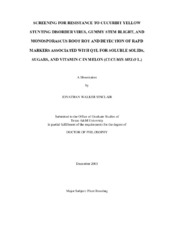| dc.contributor.advisor | Crosby, Kevin | |
| dc.contributor.advisor | Pike, Leonard | |
| dc.creator | Sinclair, Jonathan Walker | |
| dc.date.accessioned | 2005-02-17T21:08:56Z | |
| dc.date.available | 2005-02-17T21:08:56Z | |
| dc.date.created | 2003-12 | |
| dc.date.issued | 2005-02-17 | |
| dc.identifier.uri | https://hdl.handle.net/1969.1/1639 | |
| dc.description.abstract | Cucurbit yellow stunting disorder virus (CYSDV) is a relatively new virus affecting cantaloupe production in South Texas and worldwide. No resistant commercial cultivars are available. A cross of ‘Dulce’ (susceptible) x ‘TGR1551’ (resistant) was made and populations were developed for screening. Although no complete resistance was recovered, ‘TGR1551’ showed some tolerance and may be useful in breeding efforts.
Sugar components such as sucrose, fructose, glucose, and total soluble solids are major factors in determining mature melon fruit sweetness, and Vitamin C is important for human health. A F2 population was developed from the melon cross ‘Dulce’ (high values) x ‘TGR1551’ (low values) and bulked segregant analysis was used to detect random amplified polymorphic DNA (RAPD) markers associated with quantitative trait loci (QTL) for each trait. Out of 500 primers, fifteen RAPD markers were found to be significantly associated with fruit quality QTL. These markers could be useful in a marker assisted selection program to transfer these genes into a low quality cultivar or breeding line to enhance fruit quality. Gummy stem blight (Didymella brioniae) affects melon production in South Texas as well as other melon production areas in the U.S. A cross between ‘TMS’ (susceptible) and PI 140471 (resistant) was made and a F2 population was screened with a strain of the disease from South Texas. F2 plants exhibited symptoms ranging from resistant to susceptible. PI 140471 may be useful in developing commercial varieties of melon resistant to the disease in Texas. Monosporascus root rot and vine decline (Monosporascus cannonballus) affects melon production in South Texas as well as other melon production areas in the US. A cross was made between ‘TGR1551’ (moderately resistant) and ‘Deltex’ (resistant) to develop a F2 population. Both parents and the F2 were planted in infested soil. Once symptoms appeared, plant roots were removed from the soil and rated. ‘TGR1551’ showed greater resistance than ‘Deltex’ and should be utilized in breeding to develop improved resistant cultivars. | en |
| dc.format.extent | 2878746 bytes | en |
| dc.format.medium | electronic | en |
| dc.format.mimetype | application/pdf | |
| dc.language.iso | en_US | |
| dc.publisher | Texas A&M University | |
| dc.subject | resistance | en |
| dc.subject | CYSDV | en |
| dc.subject | gummy stem blight | en |
| dc.subject | monosporascus | en |
| dc.subject | RAPD | en |
| dc.subject | QTL | en |
| dc.subject | BSA | en |
| dc.subject | molecular marker | en |
| dc.subject | sugar | en |
| dc.subject | vitamin C | en |
| dc.subject | fruit quality | en |
| dc.title | Screening for resistance to cucurbit yellow stunting disorder virus, gummy stem blight, and monosporascus root rot and detection of RAPD markers associated with QLT for soluble solids, sugars, and vitamin C in melon (Cucumis melo l.) | en |
| dc.type | Book | en |
| dc.type | Thesis | en |
| thesis.degree.department | Horticultural Sciences | en |
| thesis.degree.discipline | Plant Breeding | en |
| thesis.degree.grantor | Texas A&M University | en |
| thesis.degree.name | Doctor of Philosophy | en |
| thesis.degree.level | Doctoral | en |
| dc.contributor.committeeMember | Miller, J. Creighton | |
| dc.contributor.committeeMember | Isakeit, Thomas | |
| dc.type.genre | Electronic Dissertation | en |
| dc.type.material | text | en |
| dc.format.digitalOrigin | born digital | en |


